Coleoptera
| Family | Picture | Description | Habitat |
|---|---|---|---|
| Amphizoidae (trout stream beetles) |  |
Larvae are elongated, with flattened lateral projections, and 2 short spine like cerci (tails). Adults have a broad appearance and are reddish brown to black. Length 10-15mm. | In cold mountain streams. Adults are often collected near the surface in eddies and on twigs and aquatic plants. |
| Dryopidae (long-toed water beetles) | 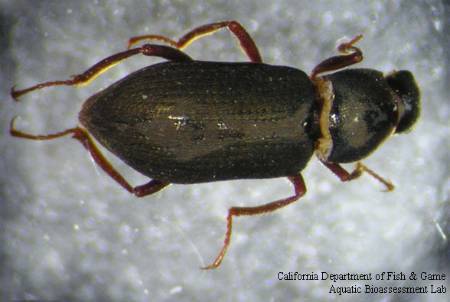 |
Larvae have clinging legs with large claws and clubbed antennae. Adult bodies are hard and the head is nearly drawn into the thorax. They have a short, thick antennae. Length 5-10mm. | Larvae are terrestrial. Adults are typically found in stream riffles and along stream margins. Only 1 genius Helichus have been collected in Utah. |
| Dytiscidae (predaceous diving beetles) | 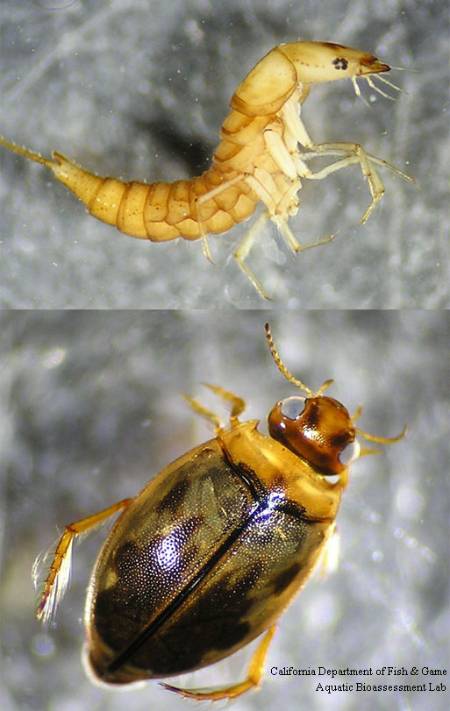 |
Larvae are elongated and spindle shaped with oar-like hind legs and 2 cerci (tails). Their heads are large with a large anterior prolongation (constriced neck). Adults are ovoid shape x-section and are shiny, brown, black, greenish, or yellow with and without spots. Adults have long antennae. Length 10-40mm. | Adults and larvae are found in slow moving streams, ponds, wetlands, and lake littoral zones. |
| Elmidae (riffle beetles) | 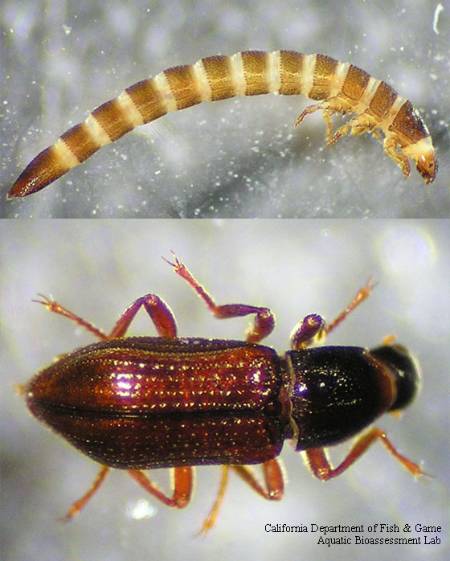 |
Larvae have stiff, cyclindrical bodies. They have a single claw and a filamentous gill on their last abdominal segment. Adults are small, hard-bodied and their heads are slightly withdrawn into their thorax. Their legs are long and have 2 claws. Length 2-8mm. | Rapid moving fresh water |
| Gyrinidae (whirligig beetles) | 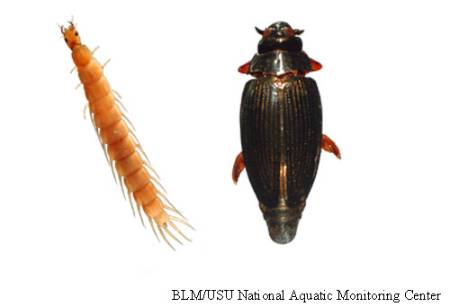 |
Larvae have elongated slender body with long lateral respiratory filaments on abdomen, and 2 pair of hooks on last abdominal segment. Length 10-30 mm. Adults may appear to have 4 eyes (1 pair looking down and 1 pair looking up. Adult bodies are black, shiny and oval. Length 3-10 mm. | Still and rapid moving fresh water margins |
| Haliplidae (crawling water beetles) | 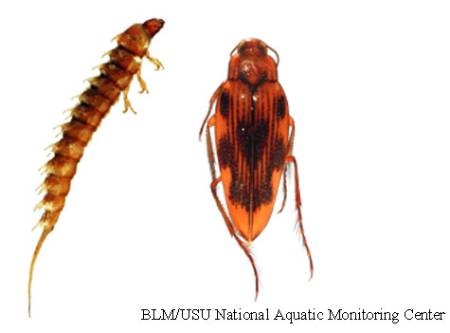 |
Larvae have an elongate, sclerotized body, two terminal filaments at the posterior end of abdomen, and some species have long dorsal projections of hairs or spines along their abdomen. Adults have small heads, a plate that covers their hind legs, and skinny legs. They are often yellow with black markings. Length 2-8 mm. | In ponds and stream pools. They are typically found in riparian debris and aquatic plants crawling along sticks and plant stems. |
| Hydrophilidae (water scavenger beetles) |  |
Larvae have large toothed jaws that are readily visible from above. They have four segmented legs. Adults have clubbed antennae and are often confused with dytiscidae. They may have a metasternal spine or keel. Length 2-40 mm. | Found in a variety of aquatic habitats. |
Hemiptera
The Hemiptera Order are "true bugs". The name comes from Hemi meaning "half" and ptera meaning "wing". The wings of Hemipterans are either entirely membranous or partially hardened (the name comes from the organisms with partially hardened wings). Insects in this order have a specialized mouth part called a proboscis or rostrum which is used to pierce tissue (mostly plant tissue, however some members of this order are predators).
| Family | Picture | Description | Habitat |
|---|---|---|---|
| Belostomatidae (toe biters, giant water bugs) | 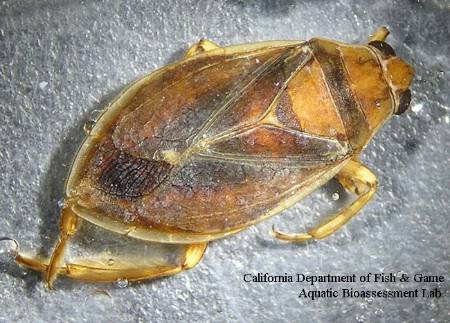 |
Belostomatidae have large, raptorial front legs and slender, elongated hind legs. Their bodies are flattened and have strap-like respiratory appendages. Length 2-12 cm. | Occur in weedy ponds, and slow moving water such as beaver ponds. They are fierce predators. |
| Corixidae (water boatmen) | 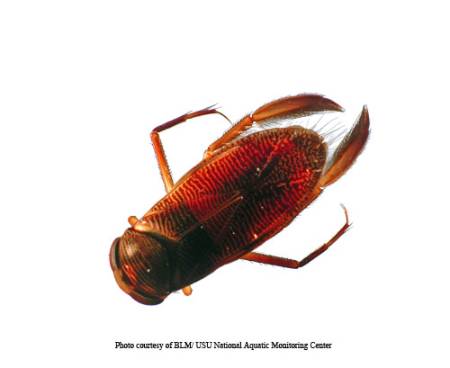 |
Corixidae have oar-like hind legs and a scoop like tarsi on their front legs. They have dark brown or black striations on their wings. Length 3-12 mm. | In still, slow moving fresh water. They are excellent swimmers. |
| Gelastrocoridae (toad bugs) | 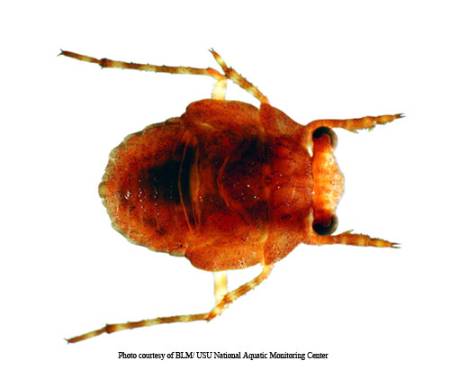 |
Gelastrocoridae have a distinct toad-like look, protruding eyes, short antennae, raptorial short fore legs, and mottled color pattern. Length 5-10 mm. | Found in southern Utah in riparian and aquatic vegetation, mud, or sand. |
| Gerridae (water skaters, water striders) |  |
Gerridae have short front legs and elongate middle and hind legs. The femur of the hind legs extends beyond the abdomen. Their bodies are dark colored. Length 3-10 mm. | In still, slow moving fresh water, often found on top of the water. |
| Hydrometridae (marsh treaders, water measurers) |  |
Hydrometridae have greyish or pale brown, bodies, the head and legs are long and slender, eyes are located behind the middle of the head. Length 8-11 mm. | Still water along the edges on vegetation |
| Naucoridae (creeping water bugs) |  |
Naucoridae have flattened, dark colored bodies that appear oval from above. The forelegs are raptorial with an enlarged femora and single claw. Length 6-15 mm. | Slow moving water, typically hot springs and desert pools |
| Nepidae (water scorpions) | 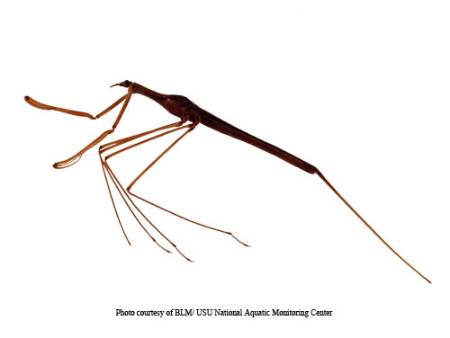 |
Nepidae have raptorial forelegs and a long slender respiratory tube at posterior end. Their bodies may be fat and squat or long and slender. Length 15-50 mm. | Ponds, typically in northern Utah |
| Notonectidae (backswimmers) | 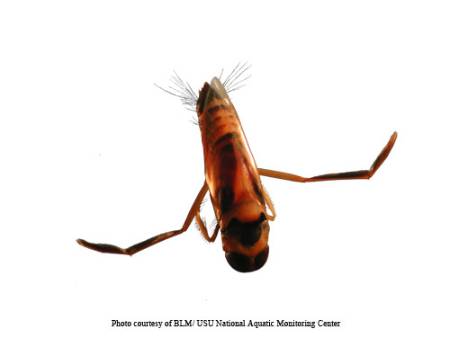 |
Notonectidae have oar-like hind legs without claws and a cylindrical body shape, often with ivory white color on body. Length 8.5-16 mm. | Slow moving water and ponds |
| Veliidae (broad shouldered water striders) | 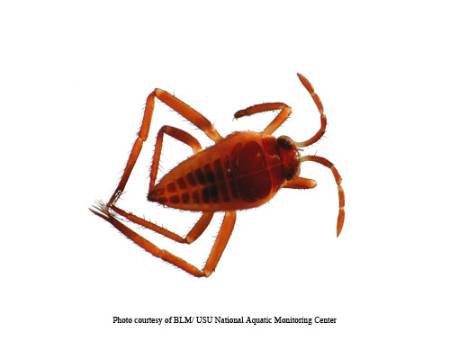 |
Veliidae has a small, broad thorax. They are similar to Gerridae, but the hind femur does not extend beyond the abdomen. Length 2-10 mm. | Commonly found in slow moving waters, but can be found in rivers and streams, too. Typically found on the water surface. |

